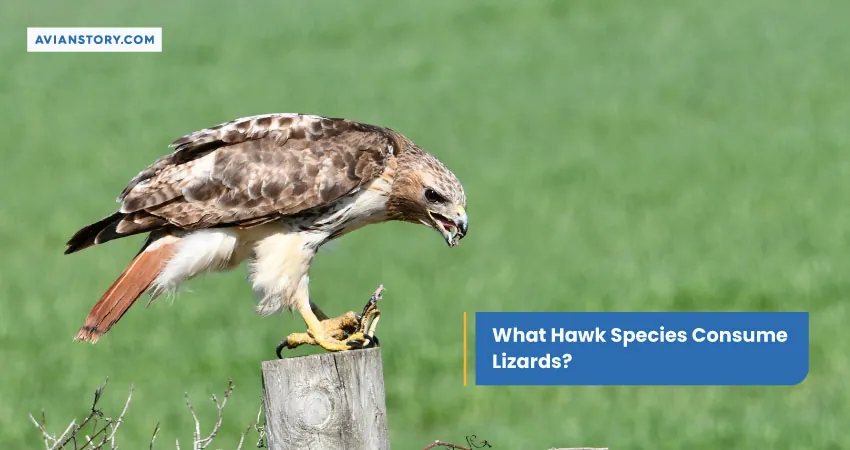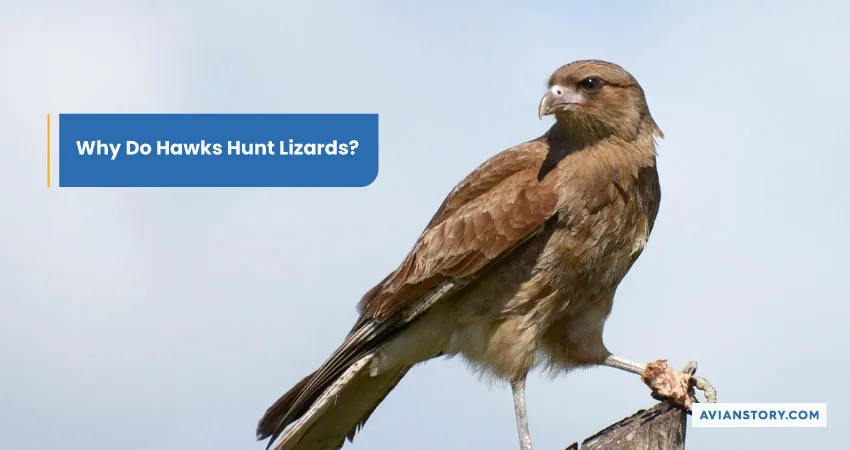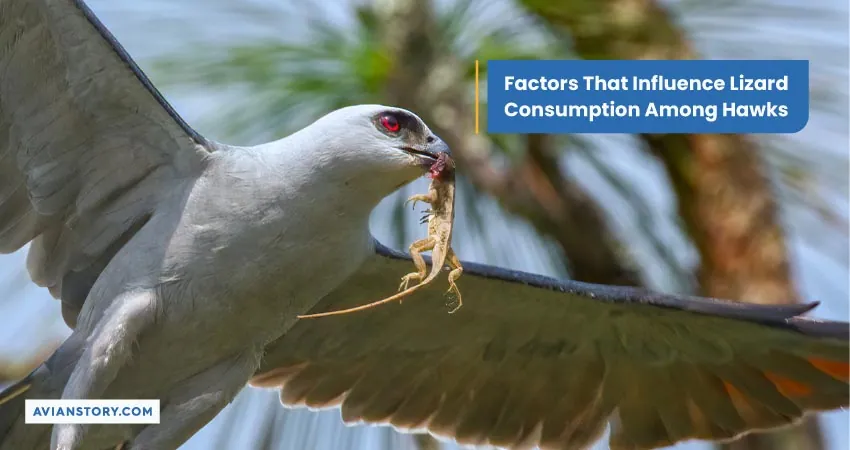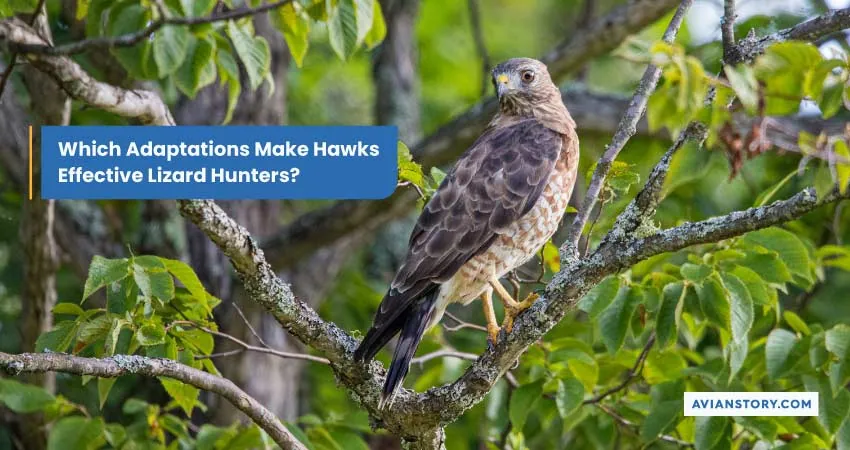Do Hawks Eat Lizards? 3 Surprising Facts Revealed!
Hawks are carnivores that hunt small animals like mice, toads, insects, and other birds for food. They typically hunt and eat whatever lives near their habitat, ranging from fish and reptiles to squirrels.
But do hawks eat lizards? Yes, hawks eat lizards whenever possible. Lizards are an excellent source of nutrients for hawks since they contain lots of fat, proteins, and minerals like iron and potassium. Hawks eat these reptiles because they are common in many places and are relatively easy to catch.
Let’s dive into what types of lizard hawks eat, how they catch them, and what effects that has on ecosystems.
What Hawk Species Consume Lizards?
All hawks can eat lizards, but some primarily consume insects, small birds, fish, and small mammals.Hawks’ diets and the type of lizards they hunt depends on habitat, so if you’re wondering, ‘What do hawks like to eat?’ find out where they live.

Hawk species that consume lizards as a significant part of their diet include;
- Harris hawk
- Broad-winged hawk
- Cooper’s hawk
- Red-tailed hawk
- Sharp-shinned hawk
- Zone-tailed hawk
- Marsh hawk
Why Do Hawks Hunt Lizards?
Hawks belong to a carnivorous group of predator birds known as raptors that eat lizards and other small animals. The main reasons hawks target lizards for food are;

1. If they live near large lizard populations
Areas near deserts and forests have large populations of lizards, so the hawks target the reptiles for food.
2. Lizards are easy to catch
Since lizards are cold-blooded, they must expose themselves and bask in the sun to maintain optimal body temperature.
You may think that lizards would be hard for hawks to spot since they are small and have camouflaging skin patterns. However, hawks have incredibly sharp eyesight, allowing them to see lizards from high up in the sky.
Since hawks are much faster than lizards, once a hawk spots a lizard, there is no escape for this reptile.
3. Lizards are a great nutrient source
Lizards are an excellent food source because they are rich in proteins, fat, and minerals. The minerals provided by lizards also promote growth and development in young hawks.
Which Types of Lizards Are Consumed By Hawks?
Hawks eat many types of lizards, but the most commonly consumed include;

A) Skinks
Skinks are a family of lizards known for their shiny scales, short legs, and elongated bodies. Examples are;
- Five-lined skink: These medium-sized lizards have five bright stripes along their back and are native to North America.
- Broad-headed skink: Broad-headed skinks are about 12 inches and are primarily found in the southeastern United States, where they live in forests.
B) Geckos
Geckos are a family of lizards that can climb smooth surfaces because of their specialized toe pads. They include;
- House geckos: These small lizards are native to Southeast Asia and Northern Australia.
- Mediterranean geckos: Mediterranean geckos are found worldwide though they originate from the Mediterranean region.
C) Anoles
This genus of lizards is small, lives in forests, and is native to the American continent.
- Green anole: Green anoles are found in the US and Caribbean and can change color from green to brown.
- Brown anole: These lizards are typically brown or gray colored and are known to compete with green anoles for habitats.
D) Whiptails
Whiptails are a genus of lizards with slender bodies and long tails that they use as a weapon. They are fast-moving, making them a hard target for predators like hawks. Examples are;
- Eastern whiptail
- Western whiptail
E) Other lizard species
Other lizard species that hawks eat include;
1. Chameleons – these lizards can change color and blend in with their environment.
2. Agama lizards – this family of lizards is native to sub-Saharan Africa. Agamas’ heads are typically differently colored than their bodies.
Factors That Influence Lizard Consumption Among Hawks
Several factors affect lizard consumption among hawks, but the most common are;

a) Habitat
According to research, there are fewer lizards in open areas than in forests. Hence, hawks that live near forests have easier access to lizards than those that live in open habitats.
b) Geographic distribution
Hawks that live in arid areas tend to have diets with more lizards than hawks in wet areas. Similarly, competition is high in areas with other predators like snakes, reducing the number of lizards the hawks consume.
c) Lizard size and behavior
Small lizards that are active and exposed during the day are easy to catch. Conversely, large, nocturnal lizards are difficult for hawks to hunt.
What Hunting Techniques Do Hawks Use To Catch Lizards?
Hawks use various techniques to hunt lizards depending on where they live. Some of the most common hunting styles include;

1. Ground hunting
This is a technique where the hawk hunts lizards by chasing them on the ground until they catch and kill them.
2. Cooperative hunting
Hawks that live in areas where prey is scarce tend to employ cooperative hunting to catch prey. They work in groups of two or more to chase, trap and catch lizards.
3. Perch hunting
When using the perch and pounce hunting technique, a hawk sits on high vantage points and scans the surrounding area for lizards. Immediately after spotting a lizard, the hawk swoops and captures the prey.
4. Aerial attacks
Hawks that use aerial attacks when hunting lizards like to fly above the reptiles before swooping down to grab them with talons.
Which Adaptations Make Hawks Effective Lizard Hunters?
As predators, hawks are highly adapted both physically and behaviorally. Here are some of the most important adaptations that make these birds so successful as lizard hunters;

Physical adaptations
Hawks possess various physical capabilities that enable them to outmaneuver lizards, including;
a) Excellent vision
A hawk’s eyesight is so good that it can detect a lizard from high in the sky and differentiate it from swaying leaves, rocks, and grass.
b) Talons
The talons on a hawk’s toes are sharp, curved, and strong enough to wrap around and grip prey tightly.
c) Beak
Hawks have sharp, strong beaks that quickly kill and rip lizards apart.
d) Adapted feet
To supplement their talons, hawks have specialized tendons in their feet that lock into place once they grab prey.
e) Agility during flight
Hawks are highly precise hunters because they can make sudden dives and turns mid-flight to adjust their flight path.
Behavioral adaptations
Besides amazing physical adaptations, hawks have behavioral advantages that give them an edge over their prey. These include;
a) Stealth and surprise
Many hawk species use stealth techniques like moving quietly and hiding behind rocks and vegetation to surprise prey while hunting.
b) Patience
Sometimes a hawk exercises patience by perching on a vantage point and remaining motionless for an extended period until prey comes along.
c) Handling elusive prey
Since hawks are intelligent, they can change hunting tactics to suit the situation and sometimes hunt in groups. Their persistence also enables them to pursue evasive prey until they catch it.
How Does Lizard Consumption Affect Ecosystems?
The consumption of lizards by hawks and other predators positively and negatively affects ecosystems. Some of the effects include;

Population control of lizard species
Hawks help control the number of lizards within an ecosystem, thereby maintaining healthy competition for resources. Ultimately, this helps maintain inter-species balance within the ecosystem.
Effect on food web dynamics and Insects
By eating lizards, hawks impact the populations of other lizard predators directly. Lizard hunting also affects other species indirectly by changing their behaviors and distribution. For instance, the number of insects in the ecosystem may increase when lizard numbers are low.
Predator-prey relationship
The consumption of lizards by hawks has complex effects on their predator-prey relationship. For example, the hawk population follows suit when the lizard population declines. This allows the lizards to increase in number, eventually leading to a rebound in the hawk population.
Are Lizards Poisonous To Hawks?

No, most lizards aren’t venomous or poisonous to hawks; even the venomous ones cannot harm hawks.
Some species of lizards have skin that produces toxic secretions to stop predators from eating them. However, since hawks rarely consume lizard skin, they are never in danger.
Human Impact On Lizard Predation

The expansion of human civilization has had many effects on various natural processes, including lizard predation. Some of these effects include;
1. Habitat destruction
Human activities like clearing vegetation for buildings destroy lizard habitats. Without habitats, lizard populations decline, reducing the number of hawks due to a lack of food.
2. Lizard hunting
Hunting lizards for food or pet food drastically reduces lizard populations and affects predator-prey relationships in unpredictable ways.
Conservation Efforts
After realizing the negative impact that human activities have on lizard predation, conservation efforts are being stepped up. Some of these efforts include;
1. Sustainable hunting
Lizard hunters are encouraged to hunt sustainably to maintain healthy lizard populations.
2. Habitat conservation
Efforts are being made to restore and conserve lizard habitats in areas where human activities have destroyed them.
3. Removing invasive species
There are efforts to eliminate invasive species and restore lizard populations in areas where they are in danger of declining severely.
Here are some answers to common questions about lizard consumption by hawks.
Can lizards escape from hawks?
No. But lizards use tricks like camouflage, running quickly, and detaching tails to avoid being caught by hawks. However, once a hawk spots a lizard and swoops in for the kill, there’s almost no way for the reptile to escape.
Are lizards the only animals hawks eat?
No, lizards are not the only animals that hawks hunt. Hawks hunt whatever small animals are available near their habitat.
Conclusion
Hawks eat lizards because they are easy to catch and are a great source of nutrients. Depending on where they live, hawks hunt various types of lizards, including chameleons, agamas, anoles, and skinks.
And hunting lizards is not straightforward, so hawks have developed sharp talons, strong beaks, and excellent eyesight to ensure success. Hawks also utilize aerial attacks and cooperative hunting techniques when chasing lizards.
Resources:
- https://www.healthline.com/nutrition/eating-lizards
- https://link.springer.com/chapter/10.1007/978-3-642-60353-2_3
- https://oxfordre.com/neuroscience/display/10.1093/acrefore/9780190264086.001.0001/acrefore-9780190264086-e-232
